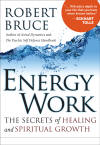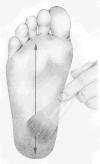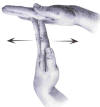Elsewhere, I provided an overview of what is termed
energy medicine. This holistic
approach to healing believes that our physicality is subordinate to and
interactive with our overall energetic nature. It is a healing
philosophy at the core of numerous alternative-health disciplines, such
as acupuncture, qigong, yoga, homeopathy, healing touch, indigenous
healing, etc. Under this philosophy, if we are compromised through
illness or injury, rebalancing who we are energetically through such
healing modalities lays the foundation for physical renewal.
This article reviews another energy-based approach
to healing, specifically body-awareness tactile imaging. As
discussed in Robert Bruce’s book Energy Work: The Secret of Healing
and Spiritual Development (Hampton Roads, 2011), the technique uses
kinesthetic (i.e., touch) visualization to direct healing energy to an
area of need.
 Although
based on the esoteric insights, of many ancient wisdom traditions, Bruce
has integrated and simplified them into a context more assimilable to
the modern Western mind. Because he used the techniques himself after
sustaining non-paralyzing, spinal injuries, Bruce’s book includes
specific visualizations relevant to SCI.
Although
based on the esoteric insights, of many ancient wisdom traditions, Bruce
has integrated and simplified them into a context more assimilable to
the modern Western mind. Because he used the techniques himself after
sustaining non-paralyzing, spinal injuries, Bruce’s book includes
specific visualizations relevant to SCI.
Although we usually think of sight when it comes to
visualization, all senses can be used. For example, picture yourself
wading through the surf on a beach in Hawaii, watching the sunset
(sight), listening to the waves crash on the reef (sound), sniffing the
fragrant plumeria in your lei (smell), sipping Kona coffee (taste), and
feeling the gritty sand wash between your toes and the surf foaming up
your legs (touch). Of all these possibilities, the tactile-imaging
process specifically involves the last type of visualization.
Alternatively, envision yourself in your backyard
reading a book. A fly lands on the back of your neck and starts crawling
around. You swat at it, but the pesky fly lands again an inch away,
slightly moving the annoying sensation. Watching this, your mischievous
wife surreptitiously rubs a feather over your neck hairs, and, thinking
that the fly has returned, you swat again. After her laughter recedes,
you have now become hypersensitive to the minutest tactile sensation on
the back of your neck, whether it’s your wife, the breeze, or real or
imagined bug. The more you try to stop thinking about that fly crawling
on you, the more it becomes the focal point of your attention.
As Bruce states in his book, “where your attention
goes, your energy flows.” Hence, if you have a cervical injury, the
focus on the real or imaginary bug crawling up and down your neck
actually directs energy to the vicinity of your injury. Although a silly
example, it does, indeed, represent the body-awareness-tactile-imaging
process.
However, instead of a crawling bug, Bruce’s
tactile-stimulation procedures routinely incorporate visualizations of a
feather, paint brush, wet sponge, or energy ball moving up and down and
through the area of interest.
 Again,
this is a kinesthetic visualization, in which the sensation is
provoked, through tactile imaging. Sometimes, the process is best
initiated by actually stroking with a paintbrush, feather, etc. But as
soon as possible, physical action should be stopped and kinesthetic
visualization started. As indicated in the spinal visualization below,
combining the kinesthetic stimulation with color visualizations can be
helpful.
Again,
this is a kinesthetic visualization, in which the sensation is
provoked, through tactile imaging. Sometimes, the process is best
initiated by actually stroking with a paintbrush, feather, etc. But as
soon as possible, physical action should be stopped and kinesthetic
visualization started. As indicated in the spinal visualization below,
combining the kinesthetic stimulation with color visualizations can be
helpful.

Although these are simple processes, readers are
encouraged to initially look at Bruce’s book to get an appreciation of
the diverse tactile-imaging visualizations available. In one of his key
visualizations, on inhalation, you would sense the feet being brushed by
a paintbrush and, in turn, that sensation coming up the legs, up through
the back and neck to the top of the head, completing the inhalation.
When exhaling, feel the energy moving down over the face and chest,
ending up in the area just below the naval. This brings energy to a key
energy storage ce nter
called the lower dantian in Eastern traditions.
nter
called the lower dantian in Eastern traditions.
Hopefully, when you energetically stimulate various
sensations by such tactile visualizations, you may be able to transfer
some of the energy into the spinal-cord injury area. Individuals with
paralysis should first get familiar with the process in body areas
unaffected by paralysis, and then try to extend the tactile sensations
into regions of paralysis. Once they become familiar with the
sensations, they can direct it into to the injury area. This may
stimulate the physical body’s own cellular, self-repair mechanisms more
strongly than usual.
Spinal Visualizations
Bruce has suggested several spinal focused
visualizations in his book. Due to space limitations, only one is
described below:
“Focus body awareness on
your tailbone. Imagine and feel an electric blue energy ball about the
size of a tennis ball forming there. Move the ball up through your spine
to the top of the back of your head, and then back to your tailbone.
Bounce the energy ball up and down, keeping the action focused in your
spine. Take about one-half to one second each way. Next focus the energy
ball to bounce up and down through the injury site and several inches
above and below. Next, use a side-to-side slicing action. Imagine a thin
disk of shining metal about five inches across. Start just below the
injury and slice side-to-side through your spine. Move the disk a 16th
of an inch up or down after every few slicing actions. Work your way
slowly and thoroughly up and down through the whole injured area, Finish
with a wrapping action as if you were wrapping a wide bandage around
your spine and this is covering and being absorbed into your spine.
Continue each action for several minutes or more.”
Elsewhere, I
provided several qigong meditative
visualizations for SCI similar to the ones described by Bruce.
These tactile-imaging visualizations are related to
a scientific phenomenon called “premovement neuronal activity,” in which
premovement thoughts trigger the firing of neurons. In addition to
Bruce’s approach, this phenomenon is relevant to numerous other healing
modalities that incorporate such visualizations. Bruce believes that
tactile-imaging techniques are clearly amenable to scientific scrutiny.
For example, electronic devices could assess nerve-stimulation activity
before and after tactile-imaging procedures have been initiated, and the
movement of the focal point of body awareness tracked.
Conclusion
Clearly, there is nothing to lose by using these
visualizations. Although walk-on-water improvements shouldn’t be
anticipated, it is important to note that in SCI there are often intact,
but dormant neurons that still go through the injury site. Studies have
shown that you only need a relatively small percentage of working
neurons to retain or regain significant function below the injury site.
As such, if tactile-imaging techniques can energetically jump start even
a few surviving neurons or, alternatively, trigger even minimal neuronal
regeneration, some life-enhancing function may accrue.